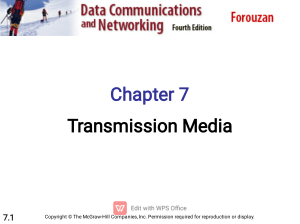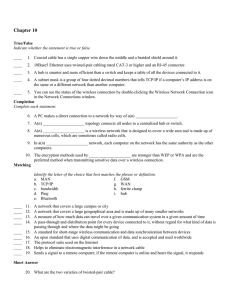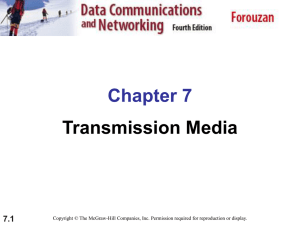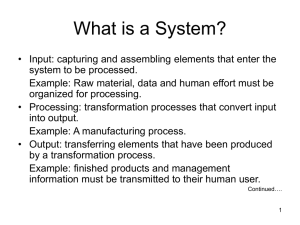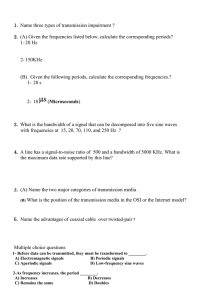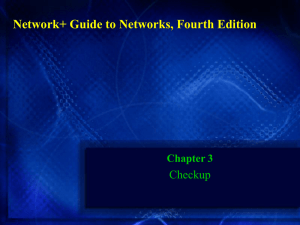Chapter 7 Transmission Media 7.1
advertisement
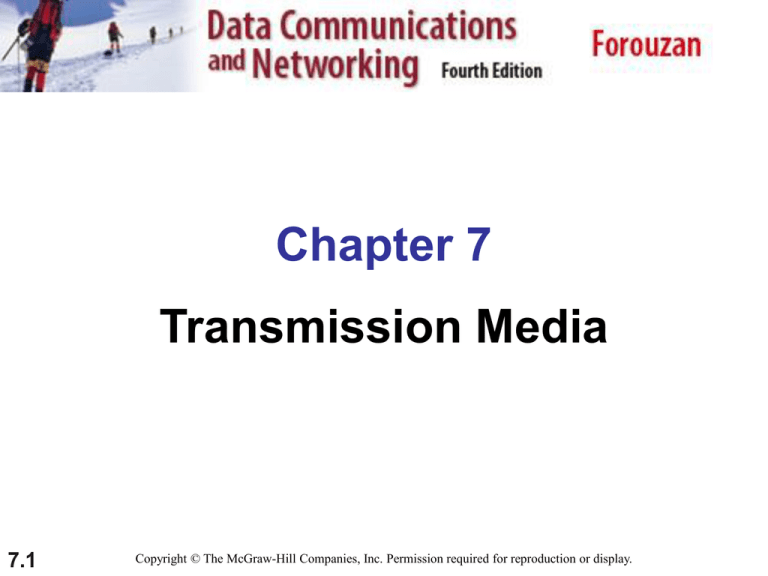
Chapter 7 Transmission Media 7.1 Copyright © The McGraw-Hill Companies, Inc. Permission required for reproduction or display. Figure 7.1 Transmission medium and physical layer 7.2 Figure 7.2 Classes of transmission media 7.3 7-1 GUIDED MEDIA Guided media, which are those that provide a conduit from one device to another, include twisted-pair cable, coaxial cable, and fiber-optic cable. Topics discussed in this section: Twisted-Pair Cable Coaxial Cable Fiber-Optic Cable 7.4 Figure 7.3 Twisted-pair cable 7.5 Figure 7.4 UTP and STP cables Example: Ethernet, phone line 7.6 UTP cables 1 – Jacket 2 – Solid twisted pair 3 – Spacer 7.7 SSTP cables 1 – Jacket 2 – Shield-braid 3 – Shield-foil 4 – Stranded twisted pair 7.8 Figure 7.5 UTP connector 7.9 Figure 7.7 Coaxial cable 7.10 Figure 7.8 BNC connectors 7.11 Twisted-pair cable vs. coaxial cable Bandwidth: coaxial > twisted-pair Transmission distance: twisted-pair > coaxial Thus cable needs frequent use of repeaters. 7.12 Figure 7.10 Bending of light ray 7.13 Figure 7.11 Optical fiber This is the reason why optical fiber cannot be bended arbitrarily. 7.14 Figure 7.14 Fiber construction 7.15 Figure 7.15 Fiber-optic cable connectors 7.16 7-2 UNGUIDED MEDIA: WIRELESS Unguided media transport electromagnetic waves without using a physical conductor. This type of communication is often referred to as wireless communication. Topics discussed in this section: Radio Waves Microwaves Infrared 7.17 Figure 7.17 Electromagnetic spectrum for wireless communication 7.18 Electromagnetic spectrum for wireless communication 7.19 Figure 7.18 Propagation methods 7.20 Table 7.4 Bands 7.21 Figure 7.19 Wireless transmission waves 7.22 Figure 7.20 Omnidirectional antenna 7.23 Example: Omnidirectional antenna Use: Wireless router 7.24 Note Radio waves are used for multicast communications, such as radio and television, and paging systems. 7.25 Figure 7.21 Unidirectional antennas 7.26 Note Microwaves are used for unicast communication such as cellular telephones, satellite networks, and wireless LANs. 7.27 Note Infrared signals can be used for shortrange communication in a closed area using line-of-sight propagation. 7.28 Example: Unidirectional Anntena Use: Wireless link connecting two remote WLANs 7.29 Example: Homemade Unidirectional Antenna - Can antenna 7.30 Example: Homemade Unidirectional Antenna Use: Cellular Anntena Tower 7.31 Advantages and Disadvantages Wireless Communication Advantages User Mobility Easy to install Reduced cost Scalability Disadvantages High data error rate Lower transmission data rates Security Battery of Mobile Devices Health Issues
